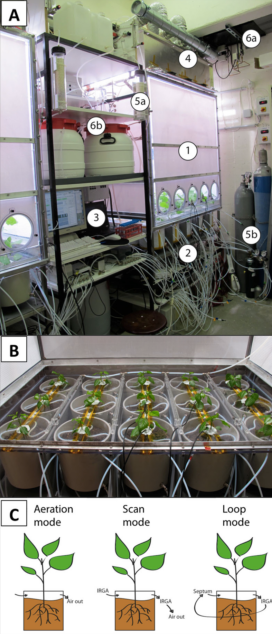Organic matter tracing in the plant-soil system: an holistic approach
Terrestrial ecosystems are a major contributor to the global carbon cycle, but many processes and fluxes of organic matter cycling within the plant-soil system are not yet well understood. Investigating the close interactions between plants and soils requires advanced methods, such as stable isotope tracing techniques. We developed a new continuous multi-isotope labelling approach using 13C , 18O and 2H to label organic matter (e.g. glucose and subsequent compounds) at its place of formation and to trace it from the leaves, through the plant, into the soil.
To develop this multi-labelling approach, we built up a unique facility called "Multi-Isotope labelling in a Controlled Environment" (MICE - Figure 1). This device has been entirely designed and built up at the University of Zurich, together with the workshop of the Physics Department (UZH) and in collaboration with the Paul-Scherrer Institut and DMP Ltd.
The MICE facility

(A) (1) Upper and (2) lower system with (3) automatic regulation of the light by the (4) plasma light engines, CO2 concentration by the (5(a)) CO2 scrubber and injection from (5b) cylinders and of the air humidity by the (6(a)) air-conditioning and the (6(b)) humidifier system.
(B) Hermetical separation of the upper (shoot) from the lower compartments (roots, rhizosphere, soil) by the bottom plate of the chamber cuboid sealed with Kapton tape along the plant rows and Terostat sealant around the stem cuttings.
(C) Overview of the pot air circulation modes for aeration with fresh air (aeration mode), CO2 concentration measurement (scan mode) or gas sampling (loop mode).
The MICE facility can be used to apply all sorts of stable isotope labelling techniques to study elemental cycling within the plant-soil system. The environmental conditions (CO2, H2O, light) are automatically controlled and the changes in CO2 and H2O fluxes can be measured (e.g. photosynthesis, evapotranspiration, soil respiration).
Associated to this labelling techniques in the MICE, we follow labelled material (living plants, decomposing organic material like roots, pyrogenic matter) in the field. The labelled material is added in mesocosms that can be followed to measure fluxes like CO2, DOC or sampled and analysed C mass balance, priming effect, compound specific molecules, physical fractionation, microbial quantity and biodiversity, among others.